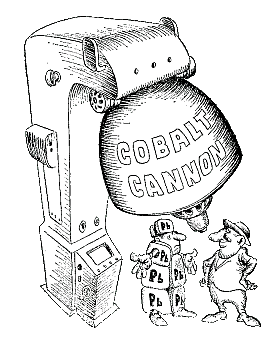107Stories About ChemistryINDEX |
56.
Chemistry and Radiation
So far chemists have not invented green leaves. But light is already used in practice for accomplishing photochemical reactions. Incidentally, photographic processes are an example of photochemistry in action. Light is the chief photographer. But the interests of chemists are not confined to light rays. There are also X-rays and radioactive radiations. They carry immense amounts of energy. For instance, X-rays are thousands, and gamma-rays, millions of times more �intensive� than light rays.  Now would chemists be likely to disregard them? And so there appeared in encyclopaedias and textbooks, in special books and publications, in popular booklets and essays a new term �radiation chemistry�. Such is the name of the branch of science which studies the action of radiations on chemical reactions. Though it is a young branch of science, it can already boast of more than a few achievements. For instance, one of the most common processes in petroleum chemistry is cracking. As a result of this process the complex organic compounds contained in petroleum split down into simpler ones. Some of the hydrocarbons they form are those contained in gasoline. Cracking is a delicate process. It requires high temperatures, the presence of catalysts, and rather a long time. All this refers to the old way. In the new way cracking needs neither heat nor chemical accelerators, and takes much less time. The new way involves the use of gamma-rays. They carry out radiation cracking. They break down the complex organic molecules. Here radiation is a destroyer. But this is not always the case. If a flow of electrons (beta-rays) is trained upon light gaseous hydrocarbons - methane, ethane, or propane - the molecules become more complex, being converted into heavier liquid hydrocarbons. This is an example of radiation synthesis. The ability of radioactive rays to �stitch� molecules is utilized in polymerization processes. We have all heard of polyethylene. But not all of us know that its production is a very complicated process, requiring high pressures, special catalysts and specific equipment. Radiation polymerization requires none of these and cuts the cost of the polyethylene in half. These are only a few of the achievements of radiation chemistry, and they are becoming more impressive from day to day. But radioactive radiations are not only man�s friend. They are also his enemy. They are a subtle and merciless enemy, causing radiation sickness. There are no universal remedies as yet for this grave disease. The best policy is to eliminate all possibility of exposure to radioactive radiations. But how? Lead blocks, concrete walls several metres thick, and heavy layers of metal and stone absorb these rays quite reliably. But this is very expensive, cumbersome and inconvenient. Imagine a man clothed in a lead suit� Chemists, where are you? Won�t you be able to find a simpler means of protecting man reliably from irradiation? The first experiments in this line (only experiments so far) have already been made. X-rays expose photographic plates and films instantly. They break down the light-sensitive layers of the silver bromide emulsion. Now here is what some Italian chemists did about four years ago. They moistened the surface of a photographic plate with a solution of the inorganic compounds - titanium sulphate and selenious acid. The plate became insensitive not only to visible light, but to X-rays as well. |





